Flat and Low Slope Roofing Materials
Reading Time: 6 minutesOur company is a professional contractor and proven roofing material supplier in Massachusetts. Over the past 22 years, we have renovated and installed hundreds of roofs in residential and commercial properties all over the region. In this post, we want to discuss low-slope roofing materials.
We specialize in flat and low-slope roofs and prefer to use only modern and Energy Star-rated materials.
We have all the necessary licenses to carry out roofing works of any complexity on commercial and residential real estate, including CSL, and the required insurance coverage. Do not doubt we always provide our clients with full package guarantees, both for materials and work.
PVC: durable and resistant to elements
PVC – membranes based on polyvinyl chloride with various plasticizers. The main advantage of PVC is tear and break resistance, but they are not the cheapest option.
The leading PVC materials manufacturers in the USA are Duro-Last, Seaman Corporation, Flex Roofing Systems, and GAF.
PROS:
1. Quite durable.
2. Most PVC membranes are reinforced.
3. Excellent insulation from moisture and leaks.
CONS:
1. Loses flexibility and cracks over time.
2. Burns out in the sun.
3. More expensive than EPDM or TPO membranes.
4. Can be mounted on the prepared surface only and cannot be installed on asphalt-based roofs.
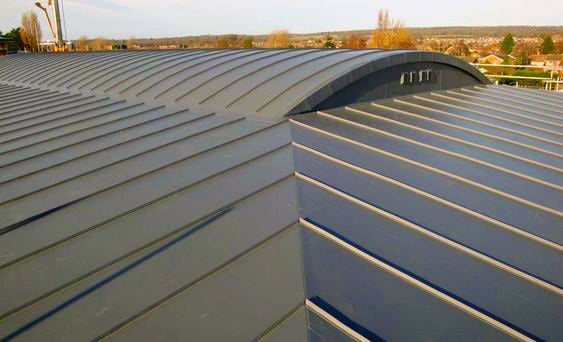
Low Slope Roofing Materials – TPO: cheaper than PVC
TPO, or thermo-plastic olephine, is a laminated roofing rubber that has been in active use for many years. TPO is a cheaper alternative to PVC but with its limitations.
The leading TPO low-slope roofing materials manufacturers are Carlisle SynTec, GAF, Johns Manville, and Firestone.
PROS:
1. Cheaper than PVC.
2. Can be used in regions with severe frost in winter.
3. Manufacturers offer white TPO membranes that do not heat the roof during the summer.
CONS:
1. Can be installed on a prepared, clean roofing surface only.
2. Not the most extended service life, even if installed correctly.
3. TPO can shrink over time. You should check the TPO roof periodically to notice cracks and leaks.
4. Not the most accessible material for an installation.
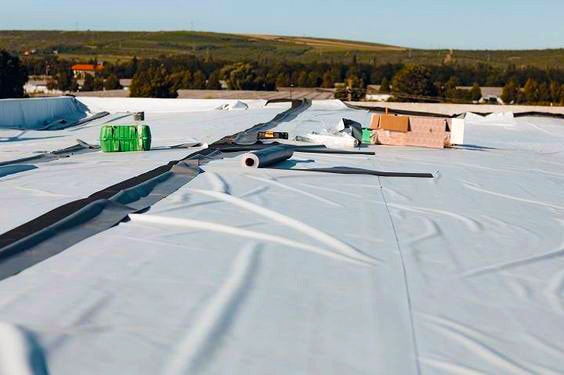
EPDM: the most inexpensive product
Ethylene Propylene Diene Monomer (EPDM), also called Synthetic Rubber roof, is a material common in all states. It is flexible, easy to install, and suitable for large roof areas, including over old bituminous roofs.
The most popular EPDM low-slope roofing materials brands are Carlisle SynTec, Firestone, and GenFlex.
PROS:
1. One of the cheapest materials.
2. Easy to install – using special glue or mechanically.
CONS:
1. Service life – about 10-15 years.
2. During the summer, this material gets very hot from the sun’s rays, heating the entire house.
3. Susceptible to mechanical damage.
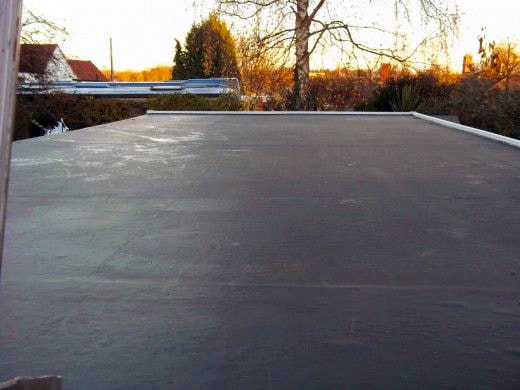
PVC Roofs: Energy Star and lifetime warranty
PVC Roofing is a modern low-slope roofing material with no analogs and similar energy-efficient options. It is a single-layer acrylic-coated PVC membrane with plasticizers, fire retardants, UV stabilizers, and other innovative additives. It provides almost eternal service life, a clean reflective surface, flexibility, and 100% leakage protection.
This material is the best solution for most flat and low-slope roofs, especially if you want to save money paying electricity bills.
The cost of PVC Roofs depends on the selected membrane – 50-mil, 80-mil membrane, and so on.
PROS:
- Energy efficient. Thanks to the unique technology, membrane roofs allow you to save on electricity bills in the summer.
- Ecologically clean.
- Durable and long-lasting. A roof with such material does not require constant maintenance. Our company installs roofs with a lifetime warranty.
- It copes well with bad weather – including snowfall and icing, stormy winds, and rainstorms.
- Large selection of membranes. We will directly offer you the optimal material of any thickness, texture, color, and style from the manufacturer. Your home will become the pride of the entire area.
- Installation and repair are fast and require only 1-2 days.
CONS:
- Membrane Roofing System is a relatively expensive material on the market. However, because of lower electricity bills, the modern membrane is even more profitable in the long term than the budgetary options like EPDM, TPO, Tar, and Gravel.
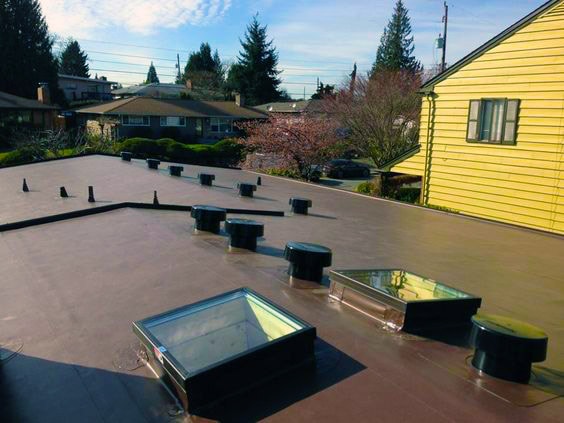
Deck Shield: perfect covering for patios
Deck Shield is the most reliable and durable roofing option for patio and exploited flat roofs. If you want to go out or even have picnics there periodically, this is the most appropriate material.
PROS:
- Deck Shield provides reliable protection against leaks in heavy rain.
- Slip-proof texture allows you to walk on this material all year round.
- Fast installation and maintainability.
CONS:
- This material is only suitable for flat roofs.
- Requires professional installation, which will prevent the appearance of leaks and cracks in the future.
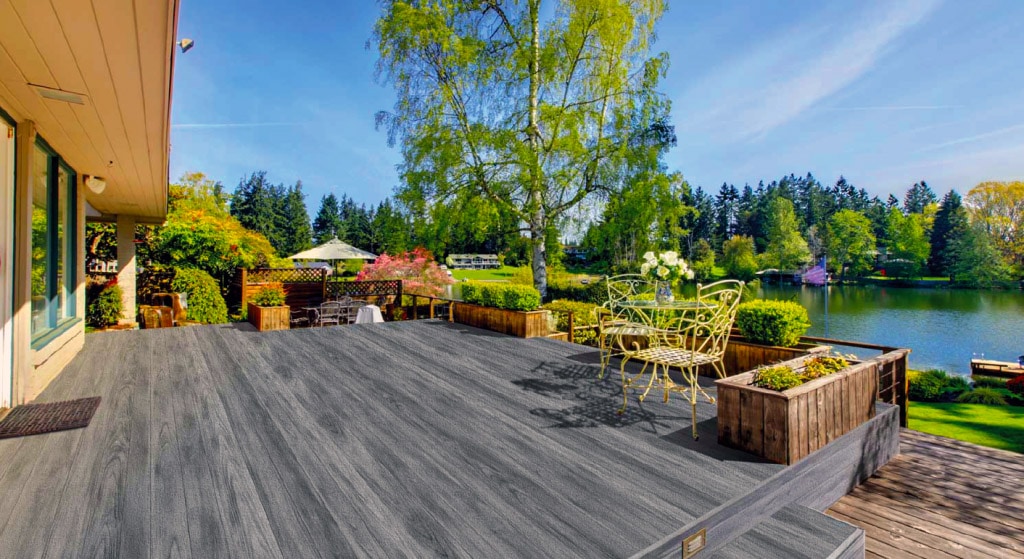
Solar PV Roofing: the roof that produces electricity
Solar Photo-Voltaic Roofing is not the most popular, but a promising material for flat roofing. PV Roofing panels generate electricity by converting the sun’s rays, the greenest energy.
For maximum efficiency, install Solar PV Roofing on the Membrane Roofing System. This way, you will save energy on air conditioning and use the “clean” energy generated by solar panels.
PROS:
- You can provide electricity not only to your house but also to other houses (with a large roof area)
- You can sell surplus energy.
- Your home will become practically independent from power grids.
CONS:
- Such material is quite expensive.
- You must mount solar panels on a prepared surface with good insulating properties.
- The maximum efficiency of the panels is available in the summer only.
- Solar panels require maintenance.
- Installation of solar panels and repair of faulty elements are relatively slow.
Green roofing: the ‘greenest’ option and a personal garden
Environmentally friendly solutions have been a trend in recent decades. A Green Roof is an opportunity to acquire a lawn or garden using the entire flat roof area.
PROS:
1. You will have a garden or lawn to relax or spend time with friends.
2. Your home will look attractive.
3. Green Roofing is the most environmentally friendly solution available.
CONS:
1. Green Roofing suits buildings with large roof areas.
2. Green Roofing requires constant maintenance.
3. Before installing such a roof, it is necessary to install drainage and other plant communications.
4. Installation of a Green Roof can take time, as a complex of works is required.
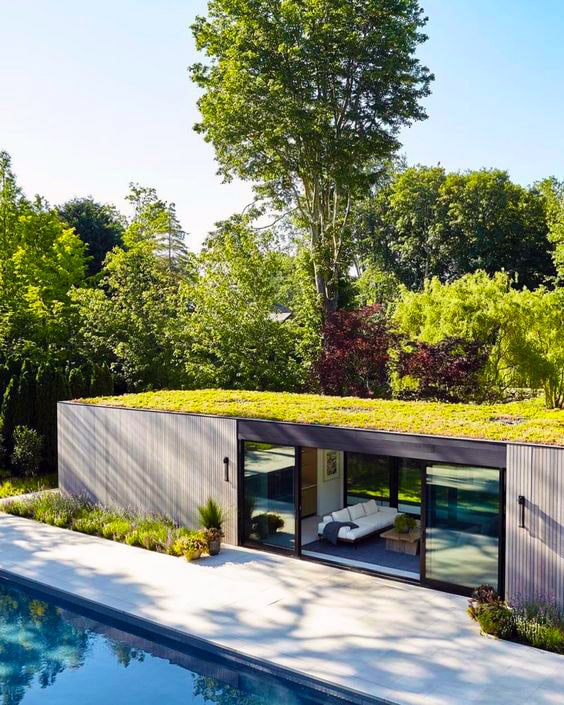
Metal Roofs as a Low Slope Roofing Material: solid and long-lived
Metal shingles are an excellent solution for low-slope roofs. Several metallic roofing materials exist, including stone-coated, corrugated, or tile-look shingles. The primary material can be galvanized steel, aluminum, or copper.
You also need to pay special attention to the preparatory work for installing a metal roof, including synthetic lining materials for ventilation and additional thermal insulation.
PROS:
- Metal is very durable when you protect it against corrosion.
- Such a roof will withstand even mechanical solid damages.
CONS:
- Metal, especially copper, is quite expensive.
- Metal roofing can be heavy. Metal exerts a load on the roof frame and the walls of the building, which have to withstand this load.
- Installation of metal shingles requires special equipment. Repairing and replacing a metal roof is challenging, as a large coverage area must be changed.
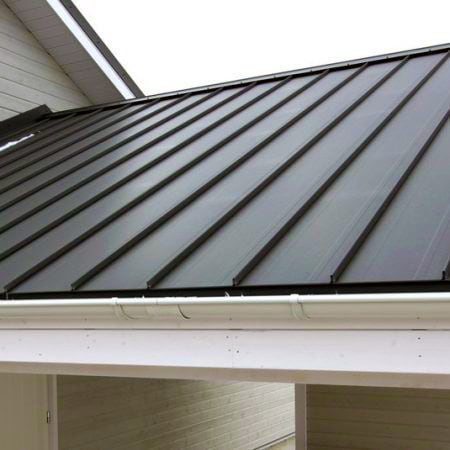
Other low slope roof materials: ‘old-school’ materials
Built-up-Roof, Bitumen, and Torch Down roofing are not common anymore. Some roofing companies still use them today, but they have many disadvantages compared to their modern counterparts, like poor anti-leaks and physical damage protection. Installing old roofing materials is usually long, not environmentally friendly, and dirty.
We prefer to use only modern and personally tested materials from leading American manufacturers.
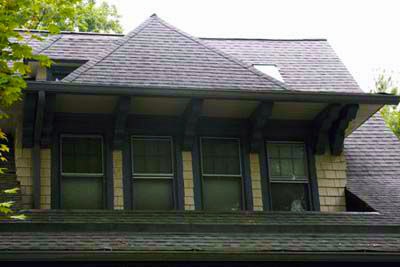
How much will my new roof cost?
We suggest you calculate the estimated cost using an online calculator to save time. Choose the main parameters – and in a second, the program will show you the approximate price of the roofing works, considering the selected materials.
Contact our specialists by phone or chat to find out the exact cost. We will immediately announce the estimate if it is possible to calculate the cost remotely. Describe the project, tell us more about your property, and we will offer the most practical solution.
Denis is the driving force behind ID Flat Roof, a leading company in Boston specializing in flat roof repair and installation for over 20 years.
Expertise:
Denis excels in PVC, TPO, EPDM, and rubber roofing. His meticulous approach ensures quality and customer satisfaction.
Innovation:
Denis incorporates cutting-edge solutions like skylights and solar PV roofing.



